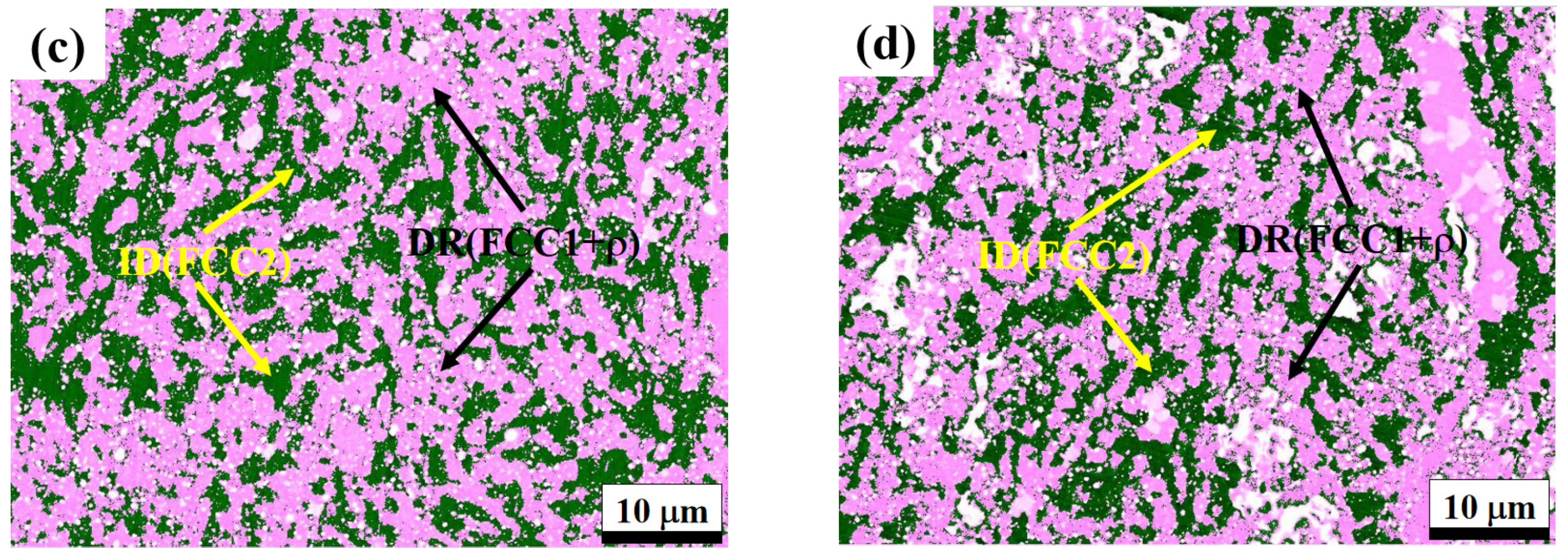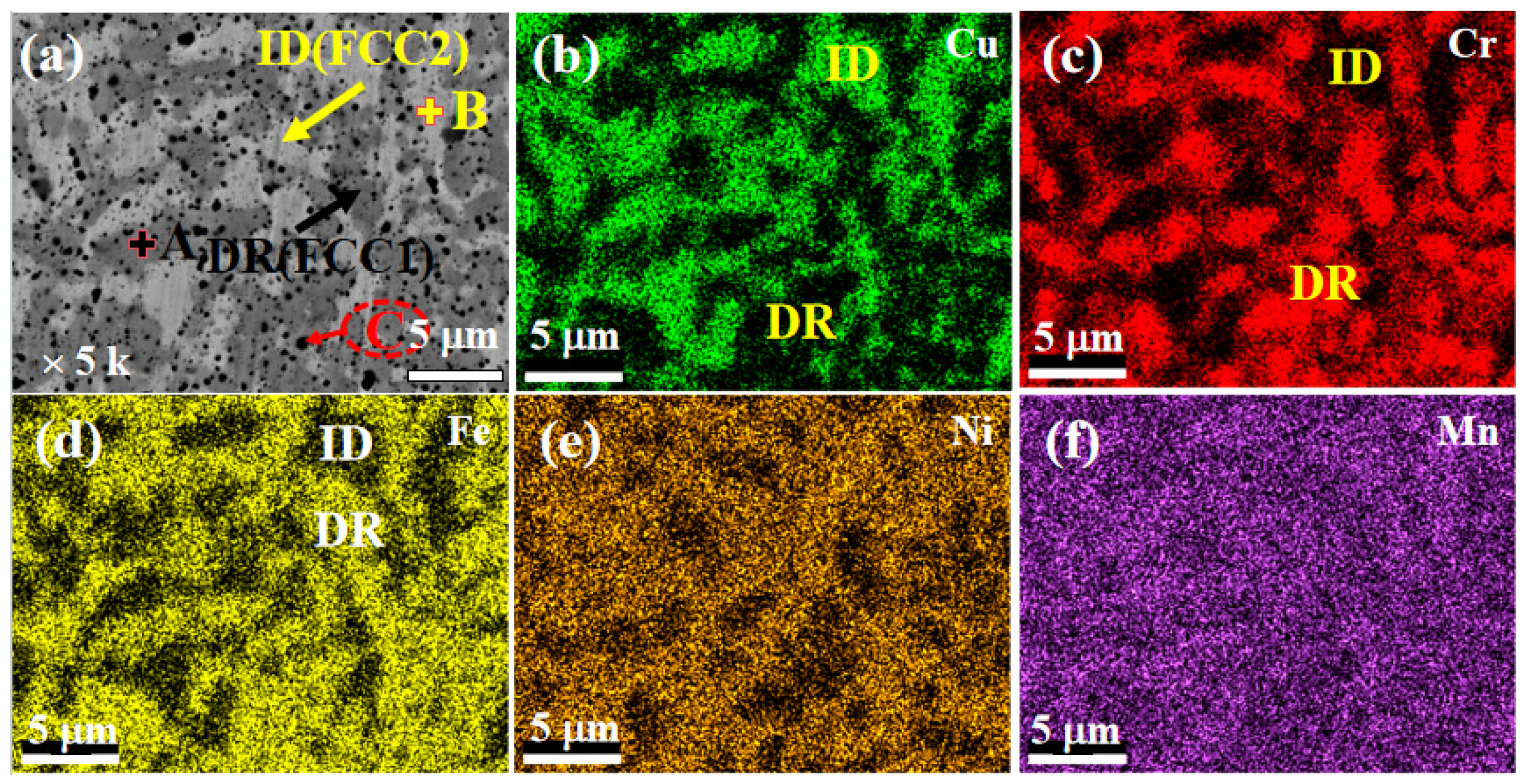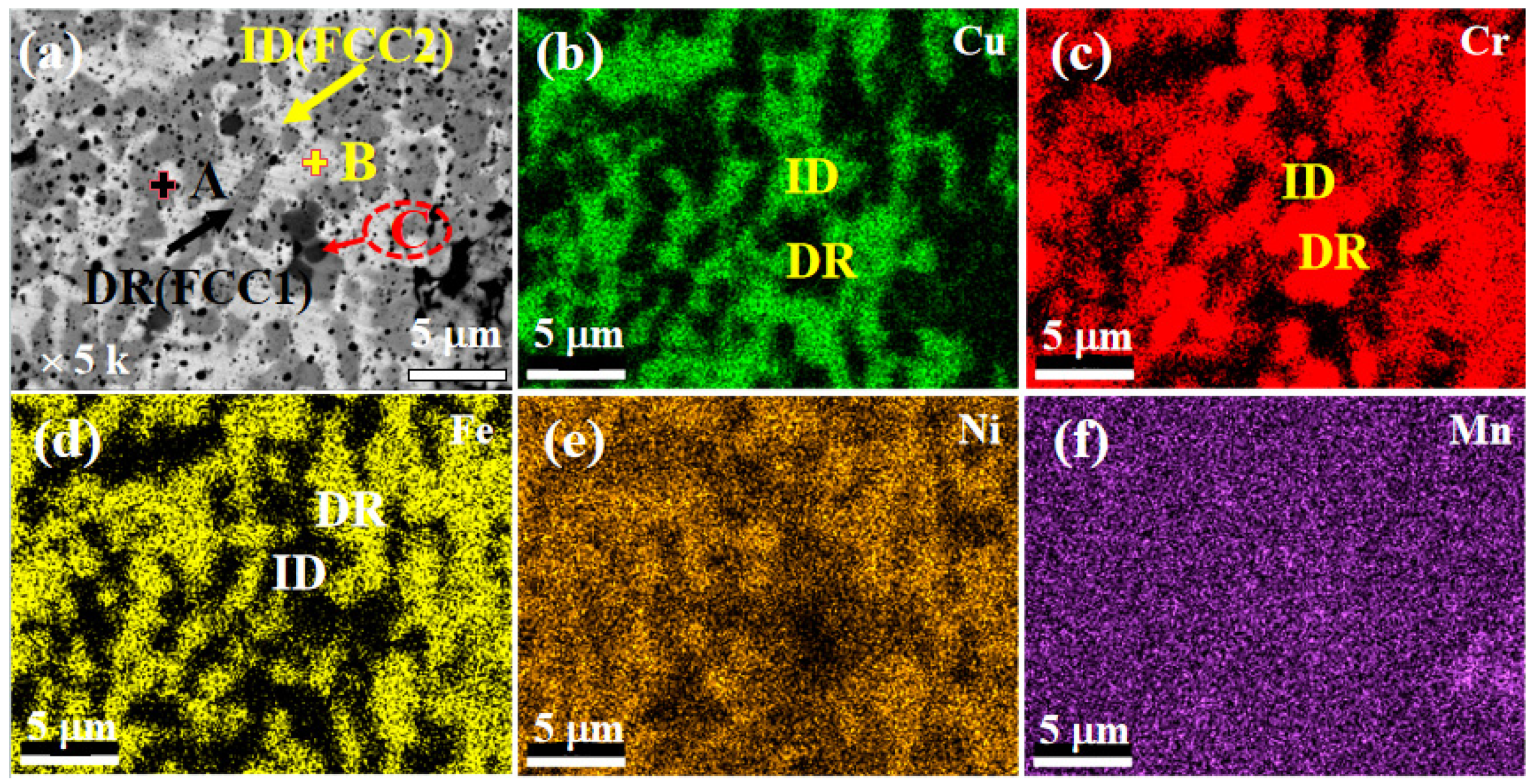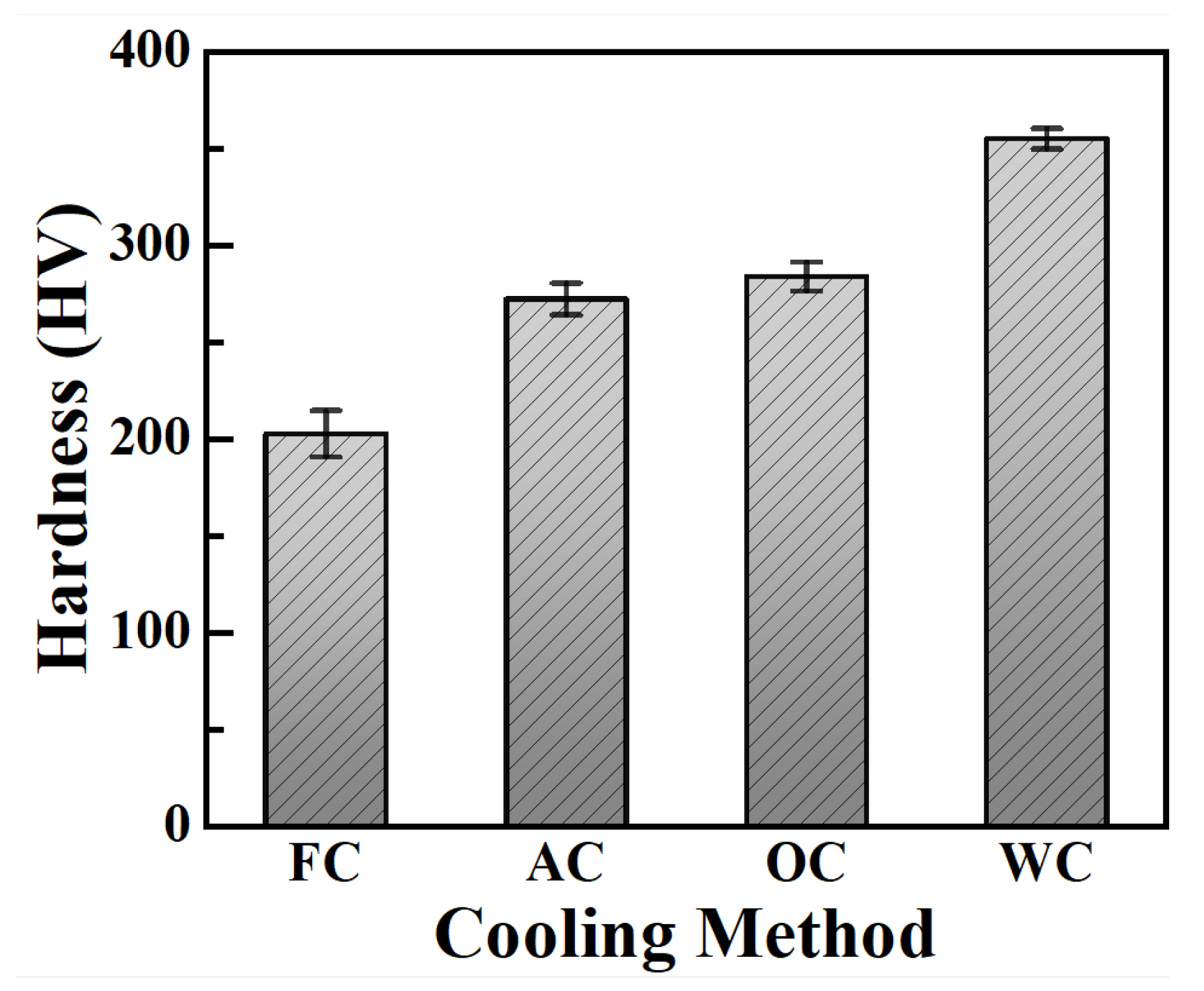Effect of Cooling Method on Microstructure and Microhardness of CuCrFeMnNi High-Entropy Alloy
Abstract
:1. Introduction
2. Materials and Methods
3. Results and Discussion
3.1. XRD Analysis
3.2. Microstructure
3.3. Hardness
4. Conclusions
Author Contributions
Funding
Institutional Review Board Statement
Informed Consent Statement
Data Availability Statement
Conflicts of Interest
References
- Yeh, J.W.; Chen, S.K.; Lin, S.J.; Can, J.Y.; Chin, T.S.; Shun, T.T.; Tsau, C.H.; Chang, S.Y. Nanostructured high entropy alloys with multiple principal elements: Novel alloy design concepts and outcomes. Adv. Eng. Mater. 2004, 6, 299–303. [Google Scholar] [CrossRef]
- Cantor, B.; Chang, I.T.H.; Knight, P.; Vincent, A.J.B. Microstructure development in equiatomic multicomponent alloys. Mater. Sci. Eng. A 2004, 375–377, 213–218. [Google Scholar] [CrossRef]
- Ranganathan, S. Alloyed pleasures: Multimetallic cocktails. Curr. Sci. 2003, 85, 1404–1406. [Google Scholar]
- Yang, X.; Zhang, Y. Prediction of high-entropy stabilized solid-solution in multi-component alloys. Mater. Chem. Phys. 2012, 132, 233–238. [Google Scholar] [CrossRef]
- Gu, Z.; He, J.Y.; Qin, Y.B.; Zhang, P.; Zhang, P.C.; Zhang, D.L.; Wu, H.J.; Xiao, L.L.; Xi, S.Q. Ultra strong FCC structured Ni8Cr4Co4Fe6W2 high entropy alloys with high strength and ductility by laser powder bed fusion. J. Alloys Compd. 2024, 992, 74580. [Google Scholar] [CrossRef]
- Guo, X.P.; Guo, Y.Q.; Yin, L.H. Study on properties of single-phase high entropy alloys with FCC structure based on the empirical electron theory. J. Alloys Compd. 2022, 896, 162892. [Google Scholar] [CrossRef]
- Xu, T.; Chen, Q.J.; Ji, L.; Zheng, Z.D.; Wang, K.; Liu, H.Y. BCC/B2 structure and dislocation strengthening behavior in high Ti content TiAlVCrNb high-entropy alloys. J. Alloys Compd. 2023, 956, 170179. [Google Scholar] [CrossRef]
- Shi, J.; Zhao, Y.W.; Jiang, C.L.; Wang, X.; Zhang, Y.Z.; Zou, D.L.; Xu, H.Y.; Huang, H.; Luo, C. Development of single-phase bcc UHfNbTi high-entropy alloy with excellent mechanical properties. Mater. Lett. 2022, 307, 130822. [Google Scholar] [CrossRef]
- Takeuchi, A.; Amiya, K.; Wada, T.; Yubuta, K.; Zhang, W. High-entropy alloys with a hexagonal close-packed structure designed by equi-atomic alloy strategy and binary phase diagrams. JOM 2014, 66, 1984–1992. [Google Scholar] [CrossRef]
- Lužnik, J.; Koželj, P.; Vrtnik, S.; Jelen, A.; Jagličić, Z.; Meden, A.; Feuerbacher, M.; Dolinšek, J. Complex magnetism of Ho-Dy-Y-Gd-Tb hexagonal high-entropy alloy. Phys. Rev. B 2015, 92, 22420122. [Google Scholar] [CrossRef]
- Ye, Q.L.; Zhang, Z.F.; Wang, Q.Y.; Xu, X.Y.; Wang, K.S.; Zhao, J.Q.; Xu, B.; Zhang, J.; Liu, D.D.; Deng, Y.D.; et al. Promoting nanoscale deformation twinning through FCC phase decomposition in AlCoCrFeMo0.05Ni2 high entropy alloy. J. Alloys Compd. 2024, 985, 174086. [Google Scholar] [CrossRef]
- Otto, F.; Dlouhý, A.; Pradeep, K.G.; Kuběnová, M.; Raabe, D.; Eggeler, G.; George, E.P. Decomposition of the single-phase high-entropy alloy CrMnFeCoNi after prolonged anneals at intermediate temperatures. Acta Mater. 2016, 112, 40–52. [Google Scholar] [CrossRef]
- Li, B.; Ming, K.S.; Bai, L.C.; Wang, J.; Zheng, S.J. Tailoring Mechanical and Electrochemical Properties of the Cr15Fe20Co35Ni20Mo10 High-Entropy Alloy via the Competition between Recrystallization and Precipitation Processes. Coatings 2022, 12, 1032. [Google Scholar] [CrossRef]
- Li, Z.Y.; Wang, X.H.; Huang, Y.Y.; Xu, Z.X.; Deng, Y.L.; Jiang, X.Y.; Yang, X.H. Microstructure, Mechanical Property, and Wear Behavior of NiAl-Based High-Entropy Alloy. Coatings 2023, 13, 1737. [Google Scholar] [CrossRef]
- Chen, S.T.; Tang, W.Y.; Kuo, Y.F.; Chen, S.Y.; Tsau, C.H.; Shun, T.T.; Yeh, J.W. Microstructure and properties of age-hardenable AlxCrFe1.5MnNi0.5 alloys. Mater. Sci. Eng. A. 2010, 527, 5818–5825. [Google Scholar] [CrossRef]
- Tsao, L.C.; Chen, C.S.; Chu, C.P. Age hardening reaction of the Al0.3CrFe1.5MnNi0.5 high entropy alloy. Mater. Des. 2012, 36, 854–858. [Google Scholar] [CrossRef]
- Ren, B.; Liu, Z.X.; Cai, B.; Wang, M.X.; Shi, L. Aging behavior of a CuCr2Fe2NiMn high-entropy alloy. Mater. Des. 2012, 33, 121–126. [Google Scholar] [CrossRef]
- Zhao, R.F.; Ren, B.; Zhang, G.P.; Liu, Z.X.; Zhang, J.J. Phase transition of as-milled and annealed CrCuFeMnNi high-entropy alloy powder. Nano 2018, 13, 1850100. [Google Scholar] [CrossRef]
- Ren, B.; Zhao, R.F. Elemental synergistic effect in CoxCrCuFeMnNi high-entropy alloys and its influence on phase and magnetic properties. J. Mater. Res. Technol. 2023, 23, 2542–2556. [Google Scholar] [CrossRef]
- Mohanty, S.; Gurao, N.P.; Biswas, K. Sinter ageing of equiatomic Al20Co20Cu20Zn20Ni20 high entropy alloy via mechanical alloying. Mater. Sci. Eng. A. 2014, 617, 211–218. [Google Scholar] [CrossRef]
- Mohanty, S.; Gurao, N.P.; Padaikathan, P.; Biswas, K. Ageing behaviour of equiatomic consolidated Al20Co20Cu20Zn20Ni20 high entropy alloy. Mater. Charact. 2017, 129, 127–134. [Google Scholar] [CrossRef]
- Yao, X.F.; Wang, W.H.; Qi, X.L.; Lv, Y.K.; Yang, W.; Li, T.Y.; Chen, J. Effects of heat treatment cooling methods on precipitated phase and mechanical properties of CoCrFeMnNi–Mo5C0.5 high entropy alloy. J. Mater. Res. Technol. 2024, 29, 3566–3574. [Google Scholar] [CrossRef]
- Xiong, K.; Huang, L.; Wang, X.; Yu, L.; Feng, W. Cooling-rate effect on microstructure and mechanical properties of Al0.5CoCrFeNi high-entropy alloy. Metals 2022, 12, 1254. [Google Scholar] [CrossRef]
- Yu, H.Y.; Fang, W.; Chang, R.B.; Bai, X.; Zhang, X.; Liu, B.X.; Jiang, Y.F.; Yin, F.X. Effects of annealing temperature and cooling medium on the microstructure and mechanical properties of a novel dual phase high entropy alloy. Mater. Charact. 2020, 163, 110291. [Google Scholar] [CrossRef]
- Faraji, A.; Farvizi, M.; Ebadzadeh, T.; Kim, H.S. Microstructure, wear performance, and mechanical properties of spark plasma-sintered AlCoCrFeNi high-entropy alloy after heat treatment. Intermetallics 2022, 149, 107656. [Google Scholar] [CrossRef]
- Wang, W.R.; Wang, W.L.; Yeh, J.W. Phases, microstructure and mechanical properties of AlxCoCrFeNi high-entropy alloys at elevated temperatures. J. Alloys Compd. 2014, 589, 143–152. [Google Scholar] [CrossRef]
- Salloom, R.; Joshi, S.S.; Dahotre, N.B.; Srinivasan, S.G. Laser surface engineering of B4C/Fe nano composite coating on low carbon steel: Experimental coupled with computational approach. Mater. Des. 2020, 190, 108576. [Google Scholar] [CrossRef]
- Zhao, R.F.; Liang, Y.C.; Ren, B.; Jiang, A.Y.; Liu, J.X.; Zhang, B.F. Effect of elemental synergism on the mechanical behavior of CoCrCuFeMnNi high-entropy alloy system. Met. Mater. Int. 2023, 30, 1505–1512. [Google Scholar] [CrossRef]








| Cooling Methods | Relative Content (%) | ||
|---|---|---|---|
| FCC1 | FCC2 | ρ | |
| FC | 27.4 | 52.2 | 20.4 |
| AC | 47.6 | 37.6 | 14.8 |
| OC | 50.1 | 34.6 | 15.3 |
| WC | 51.3 | 32.3 | 16.4 |
| Sample | Point | Cu | Cr | Fe | Mn | Ni |
|---|---|---|---|---|---|---|
| FC | A | 9.7 | 30.3 | 27.4 | 16.2 | 16.4 |
| B | 34.2 | 8.8 | 11.0 | 23.1 | 22.9 | |
| C | 16.4 | 17.6 | 21.3 | 28.1 | 16.6 | |
| AC | A | 5.1 | 33.5 | 28.8 | 12.5 | 20.1 |
| B | 32.4 | 8.2 | 14.7 | 22.8 | 21.9 | |
| C | 14.9 | 18.2 | 21.6 | 30.6 | 14.7 | |
| OC | A | 10.2 | 35.4 | 25.8 | 13.6 | 15 |
| B | 29.4 | 12.5 | 13.9 | 21.3 | 22.9 | |
| C | 14.5 | 19.3 | 23.2 | 31.2 | 11.8 | |
| WC | A | 7.2 | 36.6 | 27.4 | 11.9 | 16.9 |
| B | 39.5 | 4.4 | 5.1 | 28 | 23 | |
| C | 14.9 | 19.1 | 22.4 | 31.2 | 12.4 |
Disclaimer/Publisher’s Note: The statements, opinions and data contained in all publications are solely those of the individual author(s) and contributor(s) and not of MDPI and/or the editor(s). MDPI and/or the editor(s) disclaim responsibility for any injury to people or property resulting from any ideas, methods, instructions or products referred to in the content. |
© 2024 by the authors. Licensee MDPI, Basel, Switzerland. This article is an open access article distributed under the terms and conditions of the Creative Commons Attribution (CC BY) license (https://creativecommons.org/licenses/by/4.0/).
Share and Cite
Zhou, Y.; Zhao, R.; Geng, H.; Ren, B.; Liu, Z.; Liu, J.; Jiang, A.; Zhang, B. Effect of Cooling Method on Microstructure and Microhardness of CuCrFeMnNi High-Entropy Alloy. Coatings 2024, 14, 831. https://doi.org/10.3390/coatings14070831
Zhou Y, Zhao R, Geng H, Ren B, Liu Z, Liu J, Jiang A, Zhang B. Effect of Cooling Method on Microstructure and Microhardness of CuCrFeMnNi High-Entropy Alloy. Coatings. 2024; 14(7):831. https://doi.org/10.3390/coatings14070831
Chicago/Turabian StyleZhou, Yajun, Ruifeng Zhao, Hechuan Geng, Bo Ren, Zhongxia Liu, Jianxiu Liu, Aiyun Jiang, and Baofeng Zhang. 2024. "Effect of Cooling Method on Microstructure and Microhardness of CuCrFeMnNi High-Entropy Alloy" Coatings 14, no. 7: 831. https://doi.org/10.3390/coatings14070831
APA StyleZhou, Y., Zhao, R., Geng, H., Ren, B., Liu, Z., Liu, J., Jiang, A., & Zhang, B. (2024). Effect of Cooling Method on Microstructure and Microhardness of CuCrFeMnNi High-Entropy Alloy. Coatings, 14(7), 831. https://doi.org/10.3390/coatings14070831






